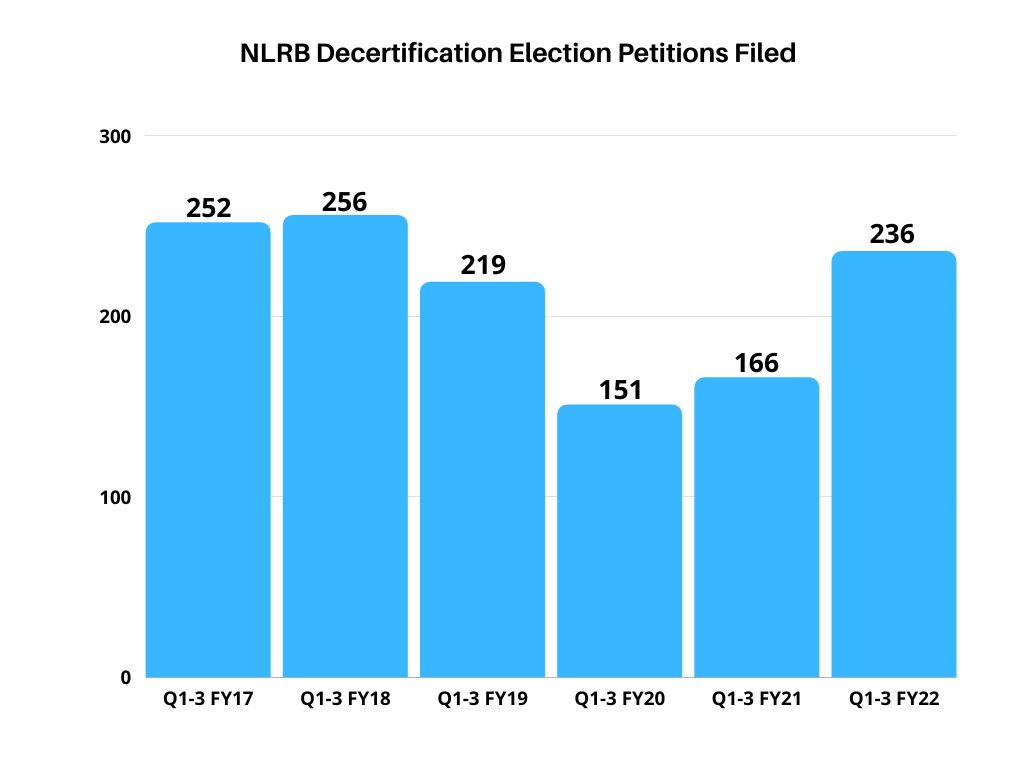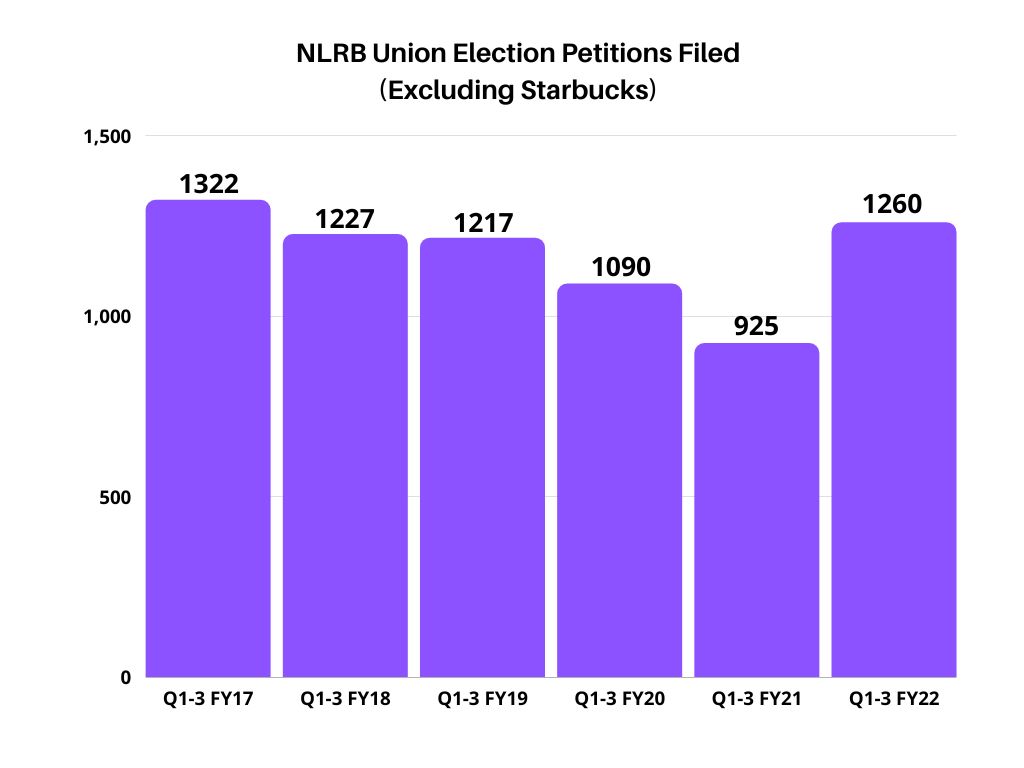The National Labor Relations Board reports a 58% increase in union election petitions through the first three quarters of the 2022 federal fiscal year. Upon first glance, this statistic may seem to reflect a major uptick in union organizing. And, on the raw numbers, it does. But there appear to be two notable causes for union elections increasing in 2022: Starbucks and COVID.
Union Election Petitions
The July 15, 2022 NLRB press release generally refers to the overall increase in “union election petitions.” There are actually an array of circumstances included in these filings. They don’t just refer to cases where a union seeks an election to determine whether they may represent employees.
There were 1,892 “union election petitions” filed with the NLRB between October 1, 2021 and June 30, 2022. Some of these were filed by unions, some by employers, and others by employees, with various objectives. 1,573 of the petitions did seek union representation of then-unrepresented employees. The second largest group were 236 petitions filed by employees seeking to oust their incumbent union. Of the remaining 84 petitions, 41 sought clarification of an existing bargaining unit, for example.
Representation Election Petitions
Petitions where a union seeks initial recognition are known as representation petitions or RC petitions. This category did indeed rise significantly in the first three quarters of FY 2022 compared the same period in FY 2021. They increased 70% overall. But there’s more to the story.
First, 313 of the 1,574 RC petitions involved Starbucks stores. That’s 20% of total representation petition filings–a highly unusual occurrence for a single employer. So, yes, these Starbucks cases are a big deal for the NLRB, which has to process all of these elections. But they’re something of a statistical anomaly in evaluating the overall state of union organizing in 2022. Very few companies operate like Starbucks, with so many corporate-owned locations scattered throughout the country. Even most quick-service food establishments use the franchise model, meaning there are numerous distinct “employers” rather than a single unionizing target.
Without the Starbucks cases, there was only a 36% increase in representation petition filings so far in FY 2022. Which brings us to the second consideration:
COVID-19.
Once you take out the rampant Starbucks unionization, FY 2022 only resembles NLRB filings before the pandemic began around March 2020. See graphs below.
The average number of RC petitions for the first three quarters of FY 2017, 2018, and 2019 was 1,255. Almost exactly the same number as were filed in the first nine months of FY 2022 (1,260).
Decertification Election Petitions
For a check on the COVID impact on NLRB union election petition filings, let’s look at decertification petitions (RD). In these cases, employees currently represented by a union are seeking to vote the union out.
We don’t have to worry about any direct Starbucks influence here. A union has to be in place at least a year before it can be voted out. None of the Starbucks stores have yet had a union for that long.
Like representation election petitions, RD filings are up in FY 2022. The 42% increase is actually higher than the Starbucks-excluded increase among RC petitions (36%).
If the 58% overall increase in “union election petitions” were due to more demand to be unionized (other than among Starbucks employees), then that wouldn’t explain the increase in decertification efforts. So, what does? Again, the answer appears to be a return to previous pre-COVID levels.

Will Union Elections Continue Increasing Beyond Pre-COVID Levels?
This question remains to be answered. Historically, about 75% of union representation elections petitions are filed in the first 3 quarters of the NLRB’s fiscal year. That means a proportionally equivalent number should be filed between July 1 and September 30, 2022. If we see that approximately 420 RC petitions (excluding Starbucks) are filed in that period, then it would continue to show a return to normalcy rather than a real shift toward increased unionization. A higher number would require further examination. For example, any apparent uptick could be a remnant of artificially low petitions during the height of the COVID pandemic. In other words, unions may still only be making up for lost time rather than experiencing fundamentally renewed interest.
Of course, if your business is union-free and wants to stay that way, the most important union election petition is the one that is or isn’t filed with your name on it. National trends are only one macro-indicator of interest in unionization. Employers should remain alert to the needs and sentiments of their own employees. Keeping them satisfied and feeling respected is the most likely path to staying out of these NLRB statistics.
For more updates on this and other topics of interest to employers, sign up for our email newsletter!
All data were obtained from the National Labor Relations Board website.


You must be logged in to post a comment.